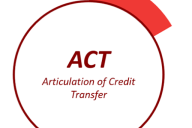You have /5 articles left.
Sign up for a free account or log in.
At a recent conference for high school counselors, a participant shared that throughout my presentation on the Transfer Virginia Portal, she had been thinking about her daughter, Kate. A high school junior, Kate was unsure of her future major, and her mom—my audience member and a high school counselor—appreciated that Kate would be able to explore different options on the portal. She was also grateful that the portal could inform Kate’s choices of IB and dual-enrollment classes and allow them to examine course transferability and major requirements at colleges throughout the state. The portal also provided Kate an opportunity to explore starting at the community college then transferring to a four-year school. “This is going to be incredibly helpful as we figure out Kate’s college plans,” her mom said as we exchanged business cards.
I am delighted that the Transfer Virginia Portal is available for Kate and that it will help her find the right college path. But the portal is an even more valuable resource for students who don’t have parents attending advising conferences, students attending poorly resourced schools without individualized college advising and students who don’t regularly encounter alumni from a range of colleges. We’ve designed it with those who don’t know where to start when making college choices in mind, for first-generation and nontraditional college students.
This is an equity issue. All students, regardless of background, should be able to explore their college options and find the right fit. Students who grow up around people who went to college hear about finding a major that aligns with their interests and skills. They hear about the value of finding a college that is a good fit in terms of course offerings, campus culture and opportunities. First-generation and nontraditional college students, in contrast, may choose and stick with a major that they don’t like or are not successful in; they may default to a college that’s not a good fit. While selecting a major and career path based on perceptions of financial stability after graduation might sound like a good plan, students who aren’t successful or happy in college are less likely to persist and graduate, and the relationship between major and salary and job satisfaction aren’t as predictable or simple as we sometimes convey. Being at the right college in the right major is a key to academic success, ultimately benefiting students, their families and our society.
Community college students have even less access to information, making their search for a good fit more challenging. Unlike high school students, they don’t receive the plethora of postcards and emails about four-year colleges. They’re rarely the target audience for colorful brochures about class size, travel abroad and internship offerings. The transfer pathways from the community colleges often lead to the local four-year school. This creates a gap in information access for students with different starting points.
In Virginia, we strive to close the information gap through the recently launched Transfer Virginia Portal, which provides overviews of all colleges in the state, course transfer equivalencies, program plans and connections to advisers. The portal is also home to transfer guides, which each college creates for its different majors. Transfer guides, which include a curricular map and additional transfer guidance, can play a central role in the college exploration process.
Each transfer guide’s curricular map incorporates the common curriculum and recommended electives, showing students how the courses they have taken transfer to the four-year institution and fulfill general education and major requirements. Virginia is building statewide common curricula in dozens of majors at the community colleges. As a result, the four-year colleges map their bachelor’s degrees from these common curricula. The transfer guides also provide information to prospective transfer students about college requirements and opportunities specific to the major and college.
Through transfer guides on the Transfer Virginia Portal, the four-year colleges provide the information students need so that they can explore different paths to a bachelor’s degree. Because the transfer guides use a standardized format, students can compare the curricular maps from any community college to all public and most private four-year colleges in the state and can compare posttransfer opportunities, including financial aid, internships, study abroad and postgraduation job opportunities. Transfer guides are free and accessible and empower transfer students on a journey to find the major and the four-year college that are the right fit for them.
Transfer guides are one instrument in the transfer student success toolbox, and they are an important one, allowing students to make informed decisions about their major and college. This, in turn, increases the likelihood that community college students will transfer to institutions that are right for them and complete their bachelor’s degrees. While all students considering colleges or looking at transfer opportunities can benefit from the information provided in the Transfer Virginia Portal, first-generation college students and others approaching the college search less informed about the process benefit in particular. As knowledge of the Transfer Virginia Portal grows, we look forward to seeing greater numbers of students completing their associate degrees and transferring to institutions that feel like the right fit.


